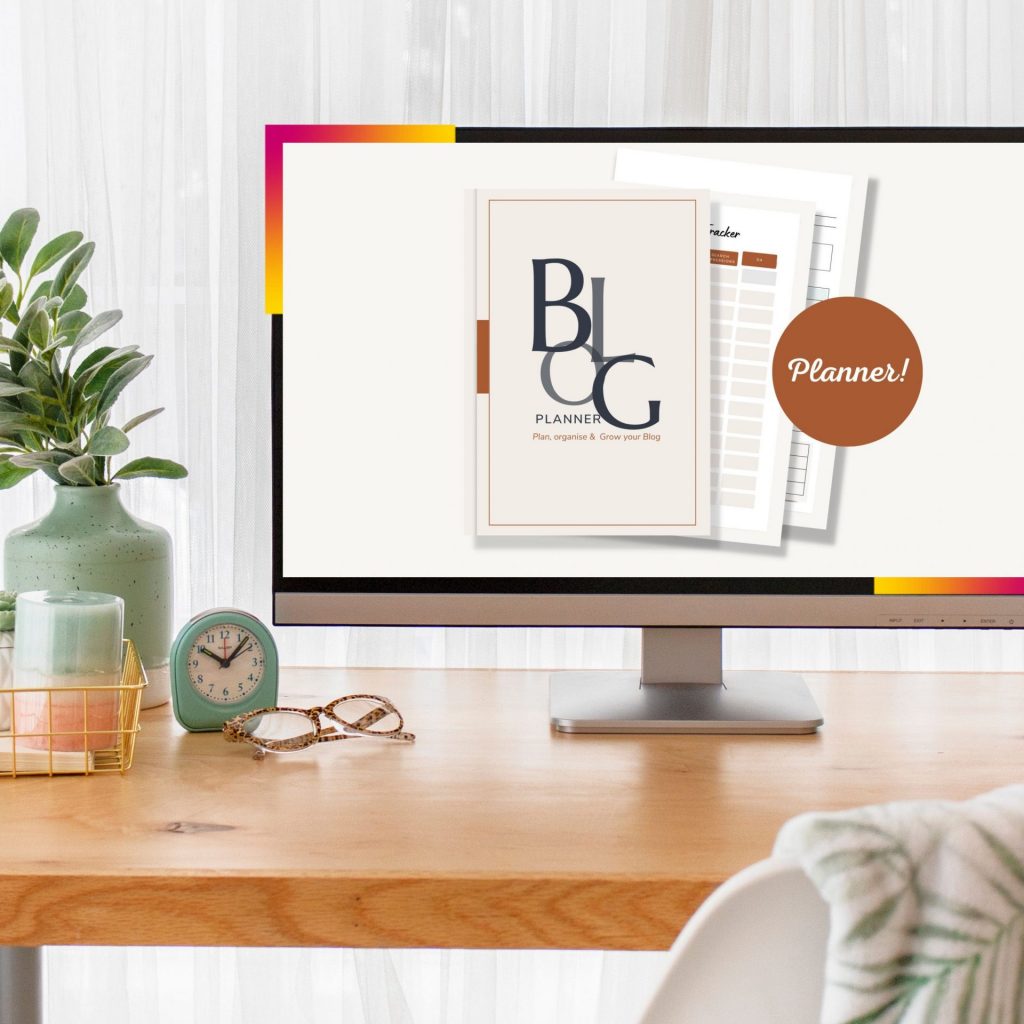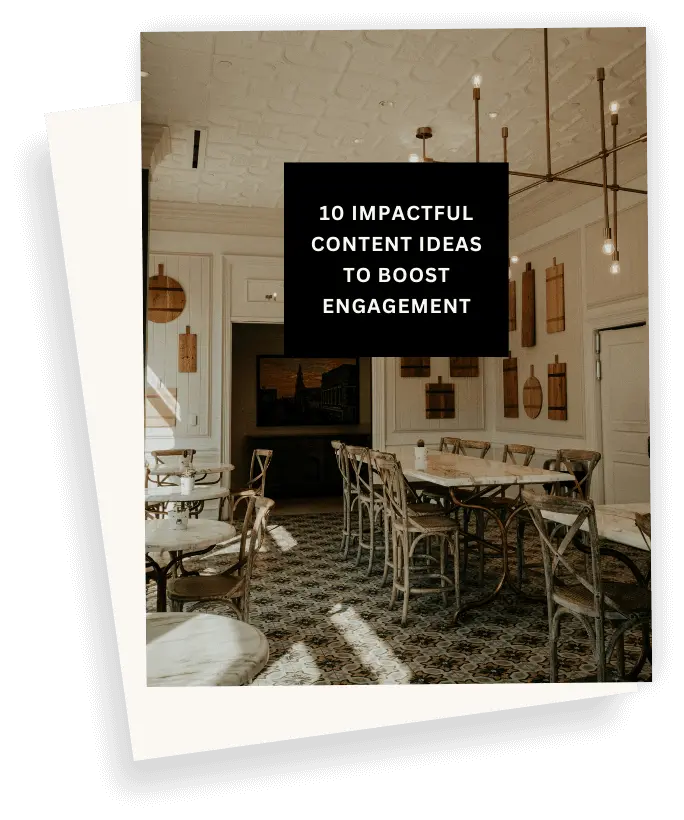
Why would I need a blog content planner when I can just go with the flow and create blog posts without spending time on blog post planning?
But a few weeks down the line, you are stuck on what next to write about and boom! You are waiting for the next inspiration, so you can write a new blog post.
You’ll never be a consistent blogger this way and eventually miss out on potential organic traffic you should be driving to your blog.
Or maybe you already realize you need a blog content plan but don’t know the steps for creating a blog content plan, and you’re already feeling overwhelmed.
Honestly, I understand your plight, and you’re not alone. Not creating a blog content plan is a common mistake new bloggers make, and I made them too.
After starting a blog, I was all over the place and read other blog posts on “what to do and what not to do.”
But no one told me that creating a blog content plan and a content strategy for your blog is super important if you want to make money or build a successful blog.
Just to mention – A blog content planner is essential for creating a blog content plan and your content strategy.
Without a content plan for your blog, you’ll be unable to serve your audience, speak to your audience’s problems and grow your blog successfully.
It doesn’t matter if you want to focus on SEO marketing, affiliate marketing, email, or Pinterest marketing. You need to learn how to plan content for your blog.
What is a Blog Content Planner?
A blog content planner is a guide with a detailed plan of action. It includes blog post ideas and strategies, publishing dates, social media and email marketing plans, audience, and even content geared toward future products.
No two blogs can have the same blog content planner because every blog will have a unique audience, products and content strategies.
Do note: you can always get the same blog planner or a blog content planner template, but each blog’s ideas and strategies will never be the same.
So, you need to dig deeper to create a content plan for your blog that will help you grow and scale your business.
And in this blog post, I’ll show you the steps for creating an effective blog content planner, and you can also snag my free Printable Blog content planner, so you can start planning right away.
Before that, why is a blog content plan important?
Why Create a Content Strategy and Blog Content Plan in 2025?
Now you know what a blog content plan is. But why do you need to plan blog content when you can go with the flow?
Below are a few reasons why you need a blog content planner and create your blog content plan asap;
1 | To Serve Your Audience Better
One of the downsides of not having a blog content strategy is that you’ll be unable to solve your audience’s problems, and sometimes even offer products no one is buying.
A little back story: I sell Canva templates, and until early 2022, I didn’t know the importance of creating content around the products and services I offer on the blog.
Yes, I was creating no-brainer products that I know my “supposed” audience needs. But I wasn’t creating blog posts around my audience’s problems.
So how would they be convinced that I truly understand their pain point and can solve their problems with my products and services?
If your content has nothing to do with your product or services.
Then, my friend, you’ll have difficulty attracting and keeping the right audience and achieving your blogging and business goals.
Therefore, to serve your audience better and create a content strategy, you need to have a content planner.
2 | It Holds you Accountable
Another reason you need to use a blog content planner is that it holds you accountable.
Because your blog content plan is part of your yearly blogging goals and because you want to meet your blog goals, you’ll have to take all necessary steps.
This also includes publishing blog posts, podcasts or even your social media posts.
For example, I’ll publish a helpful product for new bloggers and small businesses. It’s about branding kits for bloggers and businesses on a budget, and I have blog posts on this topic.
But the catch is that I had to purchase a course, thoroughly learn about this topic and product in June, and sit through classes in June just to meet this goal.
If I didn’t have these blog posts in my blog content planner alongside their importance to my audience, I’d have been procrastinating creating this content.
While a blog content plan shouldn’t be a straight jacket and should allow room for flexibility, it helps keep you on track and accountable.
3 | Helps You Stay organized and blog Consistently
A blog content planner can help you stay organized and even blog consistently.
Because in your blog content plan, you’ll have a list of blog post ideas, your blog content strategy, and the time for publishing each post.
It also helps you plan your product launches and seasonal content accordingly.
Furthermore, when you have a list of your blog post ideas for each quarter of the year.
You can never be stuck with one of the top frustrations of new bloggers, “What to blog about and when to post them”?
4 | It’s Good for SEO
One of the steps for creating a blog content plan is keyword research.
You’ll need to research the best blog post ideas and choose the right keywords.
These keywords will form the basis of your blog post ideas, so you can fill up your blog content planner with clusters of useful topics that solve your audience’s problems.
5 | It Can help you Uncover and Fill Your Content Gap
Creating a blog content plan and strategy can help you uncover your content gap and identify ways your business can improve.
And I’ll say this for the umpteenth time, I have made many mistakes when starting this blog.
And it cost me the income I could have made and growth, and you shouldn’t make them.
I will tell you how: I explored and uncovered my real competition after learning SEO.
Yes, many bloggers blog about the same topic and are successful, but for every level you’re in blogging, you have a competition you can easily unseat.
And with the right keywords strategy, you can discover the content gap between you and your competition, list blog post ideas surrounding these topics, and fill them in your blog content planner.
Do you want to unseat your competition faster? Do proper SEO research, create a blog planner, fill your blog content planner with the right topics, and write jaw-dropping, helpful blog posts.
6 | Blog Content Plan is Motivational
Creating a blog content plan is motivational because you’ll have a list of blog posts you can rate according to their importance.
For example, if you launch a product in August, you’ll have to create blog posts around that product 3-4 months before launching, so you can drive leads organically and potentially rank on Google.
And using a blog content planner can motivate you to create your blog post on time because you have a schedule to stick to.
Your blog content plan doesn’t only motivate you but keeps you in check.
7 | Using a Blog Content Planner Saves Time
Imagine every time you want to write a blog post, you’ll have to do keyword research, check pages on Google SERP, outline and write on the same day.
Even when you have other activities to do on that same day. If you’re anything like me, you’ll have to create pins and post on Pinterest, carry out client projects, be present in your home, etc.
This may make you feel overwhelmed and inefficient, and finally, procrastination and inconsistent publishing of blog posts will set in.
To avoid overwhelming yourself with the blog post creation process, your content planner can be useful because you’ll have all blog post ideas for at least 3-6 months.
And you can pick a topic, keyword, outline and write about them immediately.
I create my blog post outlines in my blog post planner a few weeks before writing about them.
8 | Gives a lot of Insight and Can Focus on What’s Working
Some important pages in my blog planner are blog income tracker, content theme planner, blog post planner pages and most importantly, SEO growth tracker.
One important goal in my blog content planner is growing my organic traffic and fixing my site’s SEO.
Ignoring SEO while depending on Pinterest is one of my biggest blogging mistakes.
And I’ve been tracking my SEO growth for a few months, from search impressions to organic clicks, Domain Rating, and conversions in terms of product sales.
I track all these and more in my blog planner. So, your blog content planner can be just more than a list of blog posts.
A blog content plan can be a powerful tool for growing your business if done rightly.
Things you Should Consider When Creating and Using a Blog Content Planner.
Now you know why creating a blog content plan is essential for growing your blog.
So, here are the essential things you should consider when planning your blog content strategy;
1 | Your Business and Blogging Goals
When planning your blog content, one key factor is your overall business and blogging goals for the year.
Each content you’ll include in your blog content plan should align with your blogging.
Because posting just any content on your blog without a blog content strategy is already a disaster for slow growth or even no growth.
Example: If your blogging goalis to grow your email list to, let’s say, 5000 subscribers and affiliate income of S10k.
In your blog content plan, you also want to write on topics that can attract subscribers to your freebies and include blog post ideas that will lead to affiliate sales, such as reviews, guides on using a product, etc.
The same ideology goes for potential products you want to launch within the year.
You need to create meaningful blog post topics that relate to your products.
This is to state that your blog content plan and goals must align.
2 | Audience and Your audience problems
Your audience is an essential factor to consider when creating a blog content plan.
Because you don’t want to create blog posts no one cares about or posts that are irrelevant to your audience.
Example: Because you want to make affiliate income and a particular niche like travel or mommy niche makes a lot of money from amazon.
And you start creating blog content around these topics when you are in the finance niche. These two niches have nothing in common.
Therefore, when creating your blog content planner, you need to consider your audience’s problems, what they care about, and how to solve them.
3 | Your Analytics and Best Performing Content
Understanding and exploring your best-performing content is not only essential for making your blog content planner.
Your analytics can be a key blog content strategy for growing your blog traffic and making more affiliate sales.
If you have some blog posts generating traffic to your site, you need to check your analytics and see the top-performing blog posts and even blog post categories.
Then research more topics around that category. You can even create topic clusters.
Creating more content around what’s working is a key blog strategy and can skyrocket your traffic.
3 | Keywords Research and your Competition
I’ll digress a bit – Ignoring your competition because you don’t want to come up as a copycat is like trying to discover earth all over again.
While I frown against copying, I believe you should spy on your competitors, especially those at the point where you hope to be.
And one way to spy on your competition is through keyword research and competition analysis.
Keywords research is vital for writing blog posts that rank on the first page of Google and even Pinterest.
Before now, Ahrefs was my number one choice, but it’s no longer budget-friendly.
Especially if you’re a new blogger trying to grow your blog so you can make money.
Some Ahrefs alternatives are Keysearch (an SEO tool that can help you do competition research).
Rank IQ is also an amazing SEO tool because it removes the guesswork and shows you the best keywords to write about.
5 | Seasons and Events Relevant to your niche
Before filling your blog content ideas in a blog content planner, consider holidays, events and seasons relevant to your niche and blog post ideas you can write around these events.
People shop a lot during the holiday season, and the last quarter of the year is the best time to grow your income with affiliate revenue or Black Friday sales.
So, in your blog content planner, note all relevant holidays, events and seasons that you can create content around and plan ahead of time for them.
With all the prerequisites and essentials for creating a blog content plan in place, let’s walk through how to plan your blog content using a blog content planner.
How to Plan Your Blog Content Using a Blog Content Planner
Ready to learn how to plan out blog content so you no longer feel confused about what to blog, when to blog about it, and quit showing up inconsistently to your audience.
Therefore, without further ado, let’s walk through the steps on how to plan blog content for a blog;
Step 1 | Identify Your Target Audience and Their Needs
Identifying your ideal reader is such an important step when researching blog topics to blog about or even products to create.
The truth is, niching down and knowing who you are talking to on a personal level will help you craft quality blog posts that hit your audience’s problems.
So, if you are new to blogging and have not decided on a niche to pick, you need to choose a blogging niche because you can’t speak to everyone.
Step 2 | Specify your Content Playing Field and Blog categories
Do you know your content playing field?
If you don’t, no problem; I’ll explain a few things that can help uncover your content playing field.
First, what is the core message of your blog? Who are you helping, and what’s your blog’s mission statement?
Think about your audience, why you started blogging, and who you are trying to reach out to.
For example – My core message is to create Templates and resources that can help bloggers and small business owners grow their businesses.
And I’m on a mission to provide busy entrepreneurs with beautiful, professional-designed time-saving Canva Templates and solutions for all your design headaches & the overwhelming feeling, helping you achieve your business goals faster (while staying on-brand).
This is my main goal; every blog post I put out is to attract small business owners, especially bloggers, to my blog and business.
Another Important Thing to consider in your Content Playing Field is your Content Format.
What Blog Content Format are you Good and Comfortable with?
Do you love creating videos, or do you prefer podcasts more than writing blog posts?
Or do you prefer listicles over how-to guides?
To avoid feeling burnt out or even abandoning your blog content plan, create more blog posts in more comfortable formats.
How Many Blog Posts, Emails, and Social Media posts Will you Make This Year?
Knowing the amount of content you want to put in a year. Especially blog posts are essential.
For example, I intend to write 100 blog posts on this blog this year. But 72 looks doable.
You don’t have to create that much content if you already have many blog posts.
When I say a good amount, I mean 100 and above. Else, create more SEO-optimized blog posts.
After deciding the number of blog posts you can create in a year, break them into quarterly and monthly plans. Also, keep in mind your holiday and seasonal content.
Your blog categories are the next essential to define in your content playing field.
Because at this point, you have a niche, you know your ideal audience and pain point, core message and mission, the number of blog posts you want to publish
Furthermore, you’ve done keyword research and have many blog post ideas in your spreadsheet.
Choose at least 3-5 Categories for your blog post in your blog content planner.
The ideal minimum number of blog categories is 4, and the maximum is 8. Also, consider adding subcategories.
However, I wouldn’t advise you to worry about blog categories. Start with at least 4 categories, and as you have more blog content, you can create more blog categories and subcategories.
Step 3 | Align Your Blog Goals with your Content Ideas
Often, new bloggers generate a bunch of content that doesn’t align with their blogging goals for the year because someone else is doing it.
Your blog content and goals for the year are not supposed to be apart; they are supposed to align together.
Imagine discovering a site on Google or Pinterest that writes content about Holiday destinations to try in New York.
And when you finally visit the site, it has freebies around blogging tips or cleaning hacks.
Maybe the blogger’s goal is to grow her email list, but her content and freebie don’t align.
Also, It’s the same when writing about a different topic or niche and promoting affiliate products that are irrelevant to your audience simply because you want a high affiliate commission.
Step 4 | Create Content Themes
Blog content themes are the main topic ideas or categories that you’ll be writing on.
Most bloggers use blog content themes to ace their blog and business goals.
Let’s paint a picture; Imagine you break your Big blogging goals and product launches into 4 sections, Q1, Q, Q3, and Q4.
And in Q3, you’ll be launching a product around email & sales funnel marketing.
You can create content throughout Q3 around email and sales funnel marketing, not just on your blog but in newsletters and even social media channels.
This is a good strategy to drive traffic to your opt-in forms and waitlist while you create this product or prepare to launch it.
Although you are new to blogging and don’t have any product, you can make your content themes around your main categories and share them weekly.
For example, I write about Canva, blogging, and brand and business tips.
In a week, I can decide to write a blog post about Canva, repurpose the blog post for Instagram, Pinterest and my email list etc.
This is to say that using content themes is one effective method for building your blog content plan.
Step 5 | Create a Blog Content Planner
I know the idea of creating a blog content planner may sound like rock science, but it’s not.
Because you don’t need a fancy tool to create a blog content planner, you can use a simple Excel or Google spreadsheet to create your blog content planner.
Or you can snag my Free Printable blog content planner template and start creating your blog content plan immediately.
N/B: I did not just design this for you. I’m using this blog content planner to plan my blog post and write a quality blog post that ranks on page one of Google.
Step 6 | Add Fixed Dates, Launches, and Holidays
Now you have a blog content planner to work with, and you’ve done all the tough stuff.
Let’s delve down to the fun stuff. I.e., Adding your blog post ideas into your blog content planner.
The first thing to add to your blog content planner is fixed dates, product launches and important events around your business.
So, in your blog content planner, add those fixed dates, for example:
- Product launch (Your proposed product launches all through the year)
- Amazon Prime day if you are an Amazon affiliate.
- Christmas, Halloween, Valentine’s day, mother’s day, Black Friday and Cyber Monday (another big day for spenders and shoppers).
- Big affiliate events etc.
Step 7 | Input Blog Post Ideas Around Seasonal Content and Fixed Dates
The next step is adding your blog post ideas around seasonal and fixed Dates into your blog content planner.
Remember, at this point, you’ve done your keyword research and have a big list of the main and additional keywords you want to rank for.
Kindly Note: For seasonal content, you need to plan and write these blog posts at least 3-6 months before the date. Because many blogs are competing for the same keywords.
If your blog is new or your domain authority is low, you need to post ahead of time to stand a chance to rank.
For example: Imagine you blog about food and want to rank for “best thanksgiving recipe,” most high-authority food blogs are already ranking for these keywords.
But to stand a chance to compete on the first page of Google, you need to write better content with great images and post yours at least 6 months before thanksgiving.
Step 9 | Fill Other Vital Blog Content Ideas to your Blog Content Planner
After adding all seasonal blog post ideas and dates, the next is to add all vital blog content ideas from your blog post and keyword ideas spreadsheet.
Now, this is where your blog content themes can come in handy.
You can decide to add vital content ideas into your blog content planner based on your theme for the week, month and even quatre of the year.
And it is essential to decide the number of blog posts you’ll be posting.
So you know how to divide your blog post categories and content strategy.
For example, I aim to reach 100 SEO-optimized blog posts for 2022, and in my content plan, I’ll post at least 3-times a week.
Aiming for 100 blog posts means I need many blog post ideas in my blog content planner.
However, an established blogger with at least 100 blog posts may post just one blog post a month, and that’s okay.
And having just 12 blog post ideas in their content planner works for them.
But I’ll advise if you are new to blogging, make sure to learn SEO and create at least 100 SEO-optimized content within your first year.
Not learning SEO right away and not knowing how to plan blog content are my biggest mistakes, and I’m still fixing them.
Instead of focusing on too many things, start learning SEO, write and post the heck out of your blog for at least 6-months before slowing down.
Step 10 | Include Your Blog Content Promotion Strategy
Another thing most bloggers often forget to include in their blog content plan and strategy is how to promote those awesome blog posts.
Unless you’ve built your blog SEO and receive tons of organic traffic from Google.
You need to promote your blog content, especially those content aligning with your blog goals and products.
The rule is to spend 20% of your time creating content and 80% promoting it.
Don’t just sit and wait for the non-existent fairy goddess of traffic to send traffic your way.
Another content strategy to include is checking out what’s trendy on Pinterest, especially if you’re in a Pinterest-friendly niche such as beauty, food, photography etc.
Pick out those trendy keywords in your niche from Pinterest, check them out on Google, do keyword research, and create clusters around them.
This is one way to drive tons of traffic from Pinterest while staying on good terms with Google.
With that noted – in your blog content planner, including the days you’ll be promoting your content and how and where you’ll be sharing.
For example; Mondays – 30 minutes on TikTok and Instagram
Tuesdays – email list and Facebook Thread
Wednesday – Facebook page
Thursday – schedule pins for Pinterest, etc.
Step 11 | Decide Platforms for Building your Audience
Before you think about sharing your content, you should decide on the platform for building your audience.
It’s easy to get carried away doing everything and being on all platforms simultaneously.
Being everywhere and doing all at once can lead to burnout, especially if you have no assistant, and blogging is usually a man show, at least for most beginner bloggers.
So, decide on at least two platforms and build your audience before expanding to other platforms.
Right now, I’m active on Pinterest, my email list (a necessity), and Instagram.
I often use Facebook groups to get one-on-one clients for designs and other services I offer.
Furthermore, don’t just learn how to plan out blog content. Building your audience and the platform where your audience hangs out is also important.
More Blog Posts to Help you Grow your Blog Faster
- 30 Ideas for Freebies + Proven Strategies for Exploding Your Email list
- How to Create Unique Gift Guide for Your Blog (Free Templates)
- 11 Creative and Easy Ways to Make Money With Canva
- How to Create a Landing Page in Flodesk (with No Website)
- How to Easily Create a Brand Board (+ Free Templates and Examples)
- 73 Strong Instagram Call to Actions Examples for Driving Engagement
Conclusion on Creating a Blog Content Strategy and Using a Blog Content Planner
One of the challenges new bloggers struggle with is what to write about, how to grow your traffic and make money blogging, and most importantly, how to stop being all over the place.
I’ll tell you, the first solution to most of your blog problems is your blog content, writing the right content, attracting, and solving your audience problems.
You can’t have 100 poorly written blog posts without SEO and no blog promotion and expect to drive traffic to your blog.
And if you have a product that’s not making any sales, go back and inspect them.
Do you have well-researched SEO blog content around that product you’re actively promoting on Pinterest and where your audience hangs out?
A blog content plan and strategy allow you to create a streamlined system for your content creation, grow your traffic and blog income, and it’s no rocket science.
So plan your blog content and get organized. Remember, it doesn’t have to be complicated.
You can use my simple blog content planner and nail your blog content plan.
Do you plan your content ahead of time? Are you a paper and pen kinda person, or do you use a digital content planner? Let me know in the comments.







